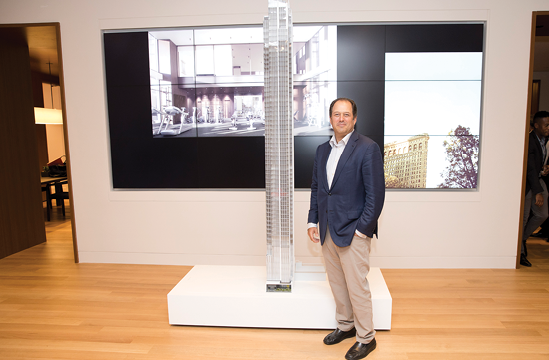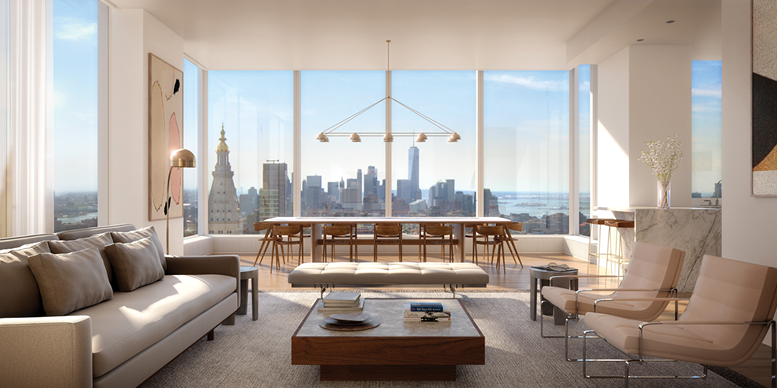- Home
- Media Kit
- Current Issue
- Past Issues
- Ad Specs-Submission
- Ad Print Settings
- Reprints (PDF)
- Photo Specifications (PDF)
- Contact Us

![]()
ONLINE


Evan Stein next to a model of Madison House
Telling a Story
Editors’ Note
Evan Stein is the President of JD Carlisle Development and their in-house construction company, MD Carlisle Construction. The company manages over 600,000 square feet of commercial space and more than 2,000 residential units. Stein has successfully led the team through significant development projects, including Morton Square, Gramercy Green, The Cielo and The Beatrice. Over 50 years ago, MD Carlisle was founded by Stein’s grandfather and hero, Harry Feldman. After graduating from college in the early 1990s, Stein started out in the family business where he computerized the company’s accounting systems. Hoping to gain more experience in the construction field, he stepped into the role of assistant superintendent. His daily work on the construction site taught him the ropes of real estate development and helped prepare him for his future at JD Carlisle.
Company Brief
JD Carlisle LLC has earned a reputation for being a thoughtful and decisive real estate developer, a combination that has resulted in properties of distinction. The company was founded by Harry Feldman in the late 1940s as Carlisle Construction Company. In 1972, Feldman established MD Carlisle Construction Corp., later partnering with Jules Demchick who has served as Chairman since 1998. The company assembles first-class teams that understand the requirements of contemporary, luxury properties that evoke a strong sense of place. They have designed and developed self-contained communities for more than 5,000 homes in ten locations as well as commercial facilities. Since the inception of these companies, they have generated over $10 billion worth of properties in the United States.

Madison House residence living area
Will you highlight the history and heritage of JD Carlisle Development and how the firm has evolved?
JD Carlisle is probably the second or third iteration in this organization, which started back in the 1940s. My grandfather came out of the Navy and he was an engineer in the war and he came into New York and he worked for my great grandfather in a plumbing company. One thing led to another and they went from a plumbing company to a carpentry company and on and on to where they eventually became a general contractor in Manhattan. They were doing all kinds of projects throughout the city and then started taking their shot in general development. While the company really started in the 1940s, JD Carlisle was formed in the mid-1980s as a partnership between my partner Jules Demchick and the Carlisle Group. We’ve been around ever since.
Is JD Carlisle primarily focused on the New York City market?
In the current environment we’ve been looking broader, but we’ve also been very successful in focusing in the New York City market. I think anyone would tell you that being a real estate developer in New York City is being in the major leagues and going anywhere else really isn’t the most appealing. We certainly know the skill sets translate, but what we do is so refined and so detail-oriented that doing it in other marketplaces is a little bit more of a challenge. Here we know everybody, have a long history and can develop successfully because we know what to do. I think that our philosophy is that every site is its own thing and tells its own story.
Understanding what those stories could be in other marketplaces would take a little bit of time for us to figure out.
Will you highlight Madison House and how the building is positioned in the market?
We didn’t set out for it to be a 10-cornered building; we set out to come up with the most unique layouts we could come up with. We knew we were coming into a market that was on the challenging side. Our philosophy is that for each apartment, there were going to be 10 potential buyers and we looked at what we could do to be unique and to stand out. We wanted to do something that our competition couldn’t. We evaluated the height and the structure of the building. Once we started figuring out the structural elements, the real concrete, steel and nuts and bolts types of things, we then started to figure out how to lay it out.
As we started this process, we decided we really wanted to do something here where every apartment stands on its own. It’s not a matter of just fitting it into the building, it’s a matter of the building wrapping around the apartments and that’s how we got to our unique layout. It was a challenge for our architect and I give full credit to Handel Architects who worked with us to make it all feel as if it’s a symmetrical elegant building. However, there is not really symmetry to the structure whatsoever, it was designed from the inside out so the experience for our end purchaser is more unique.
How critical is it for a building like Madison House to offer a broad range of amenities?
This goes back to the story of the building you’re trying to sell. Madison House lent itself very well to certain types of amenities with, for lack of a better term, more of a country club feel. We didn’t want to just have a swimming pool, we wanted to have an Olympic-size swimming pool. We didn’t want to have a private dining room, we wanted to have a private dining room that you could really use. If you’re going to have an amenity in a building, it is important that it be done right. It can’t just be a check-off-the-box kind of thing.
Certainly in this marketplace, it helps to differentiate yourself in a building with certain amenities that people are going to use, but we were never a big fan of having things just for the sake of having them. It’s important for any development to offer something other than just a living space with residents. In our philosophy, you’re not just going up to your apartment, you’re walking into your neighborhood. Hopefully, people want to live in the neighborhood that is the most well-rounded. They want to move into a neighborhood that is the most diverse and they want to live in a neighborhood that feels comfortable and is consistent with what they have in their apartments. That is what we set out to do in this building and I think we achieved it.![]()